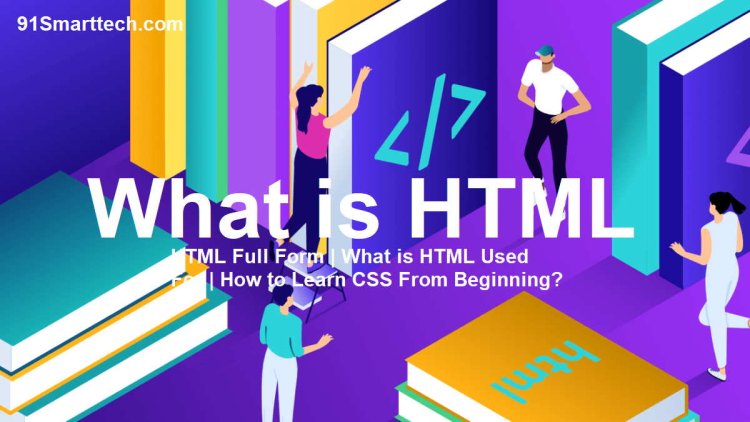What is HTML | HTML Full Form | What is HTML Used For | How to Learn HTML From Beginning?
So what is HTML after all? What is its use? Today we will talk about all those things. Today I will talk to you about one thing how you can learn HTML.

If you are a person who is interested in coding programming or both, then you must have heard the name STML. However, till now you only know about HTML which is a language through which web pages are created. If you are curious to know about HTML in this way, then let us know “What is HTML” “What is the full form of HTML” and “What are the features of HTML.”
But the introduction of HTML is not limited to this only, nor is the definition of HTML limited to this, but HTML is much more than this. So today we will get complete information about HTML in this article.
What is HTML | HTML Full Form | What is HTML Used For | How to Learn HTML From Beginning?
Also Read: What is JPEG? | JPEG Full Form | What is JPEG Used For...
What is HTML?
HTML, which is called Hyper Text Markup Language, can be considered a computer language. HTML language is most commonly used across the world to create the web pages that you and I open on our devices.
If explained to you in simple language, HTML is a type of programming language, that uses software programmers to create web pages.
All the webpages that you see in the browser of your computer laptop or mobile are created through Hypertext Markup Language. It is also very important to know here that different types of tags are available in HTML.
Below, the full form of HTML has also been explained to you by separating Hypertext and Markup language.
Hyper Text
In hypertext, such a text is available in which links are available on the text. If you might have noticed, when you look at any webpage, there is a link in one word and when you click on it, you immediately go to another webpage. This is called hypertext.
Markup Language
It is a computer language using which the structure of a webpage is developed. HTML tags are also used in this. Every tag has some text in the middle in which some mark is definitely available. Such as tables, paragraphs, headings, italics,s, etc., this is called markup.
What is the Full Form of HTML?: HTML Full Form
[ HTML: Hypertext Markup Language ]
HTML Full Form: The full form of HTML is Hyper Markup Language. HyperText Markup Language is a standard language. This language is used to display the document on the webpage in the browser. HyperText Markup Language can be used with Cascading Style Sheets and JavaScript.
What is HTML Used For
Hypertext markup language is used in the following places.
- Hypertext Markup Language is used by programmers to create a beautiful webpage.
- By using Hypertext Markup Language, one page is connected to another page by the programmer.
- Hypertext markup language is used by the website developer to design the website as per his choice.
- Hypertext markup language is also used to create web-based documents.
- Hypertext Markup Language proves to be very useful in performing tasks related to data entry.
- Hypertext markup language is also used to create a variety of graphically rich games.
What Language is HTML?
HTML i.e. Hypertext Markup Language is a markup coding language. Hypertext markup language uses data that is separated into separate HTML tags.
Hypertext Markup Language provides information to the web browser about what different page elements are and where to go on the web page during the loading of the web page.
Also Read: What is Java | What is Java Programming Used for And How...

How to Learn HTML From Beginning?
If you put all your attention towards learning this language, then in a very short time you will be successful in learning Hypertext Markup Language. You can learn Hyper Text Markup Language at home with the help of a computer and internet or you can take the help of any coaching class. Below we are telling you some ways to learn Hyper Text Markup Language.
1: Learn HTML Online
If you want to learn Hyper Text Markup Language at home, then for this you should get information about how to learn HTML online. If you want, you can get free HTML training through any online source at your convenience.
You will find many such websites available on the internet, where training in Hyper Text Markup Language is given absolutely free. Below we have also given you the names of some popular websites where you can create an account and with the help of these websites, you can start learning Hypertext Markup Language from today itself.
- W3Schools.com
- Html.com
- Htmldog.com
- Codecademy.com
- Learn-html.org
- Javatpoint.com
- Tutorialrepublic.com
- Udemy.com
- TutorialsPoint.com
- TutorialPandit.com
2: Learn HTML from Books
You will find many such books online and offline, in which complete information about Hyper Text Markup Language is given in detail.
In this way, if you want to learn Hyper Text Markup Language by practicing it through books, then you have to buy books in Hindi/English language and practice what is mentioned in it through your computer or desktop. By doing this you will gradually become successful in gaining very good information about Hyper Text Markup Language.
3: Learn from YouTube
If you have a laptop or computer and an internet connection, you can use YouTube to learn HTML for free. There are many channels on YouTube where HTML-related videos are uploaded for free.
How to Learn HTML Full Course for Beginners In Hindi
You can watch such videos and practice what is being told in the video through your desktop computer or laptop. There are many such channels available on YouTube where HTML is taught series by series.
How to Learn HTML Full Course for Beginners In Hindi
4: Take a web designing course
If you want to learn Hyper Text Markup Language offline, then for this you have to find out about any institute nearby where a web designing course is conducted and you have to go there and get admission in this course.
In web designing courses, you are given training in Hypertext Markup Language as well as other web technologies such as Cascading Style Sheets and JavaScript.
However, remember that before taking admission to any institute, get complete information about the course fees and only then take admission in the institute. After completing the course from the institute, you must get a certificate from there which will be very useful for you in the future.
5: Take offline tutoring
This is also like joining the course. However, here you do not need to take admission, rather you have to take training in Hypertext Markup Language from someone living near you who has learned this language. You will be given detailed information about Hypertext Markup Language by a person who has already learned this language.
History of HTML
WWW was discovered by Tim Berners-Lee in the year 1989. Hypertext Markup Language was discovered by Tim Berners-Lee in 1991, which is called HTML in short.
HTML5 Plus was drafted in the year 1993 by a person named Dave Raggett. HTML 2.0 was defined in 1995 by the Hypertext Markup Language Working Group. Tim Berners-Lee is called the father of Hypertext Markup Language.
Also Read: What is CSS | CSS Full Form | Types of CSS | How to Learn...

How does HTML work?
Hypertext markup language follows a top-down approach. This means that in Hyper Text Markup Language, the top portion is the first to take the loading and after that, the loading starts downwards.
Only the work of designing the web page is done through Hypertext Markup Language and in this the entire structure of the web page is developed. Let us tell you that to write HTML code, the file should be. HTML or. HTML. The HTML file is saved by extension.
When any file is saved with the extension of HTML, we can upload it to a web server or computer and view it through a browser.
Advantages of HTML
Let us further get information about what are the advantages of Hyper Text Markup Language or what are the benefits of Hyper Text Markup Language.
- We told at the beginning of the article that Hyper Text Markup Language is very simple. Therefore any programmer can easily use Hypertext Markup Language. It is a simple language. That is why it is very easy to learn and can be learned quickly.
- Hypertext Markup Language is called a free-of-cost language, which means that you do not need to purchase any type of software to use this language.
- Almost all types of browsers are supported by Hypertext Markup Language.
- It is very easy to edit Hyper Text Markup Language and you can also modify it whenever you want.
- The biggest advantage of Hypertext Markup Language is that you can use this language with languages like PHP, JavaScript, and CSS.
- It can be easily compressed into a zip file, due to which it is very easy to download its code.
- HyperText Markup Language is a user-friendly language.
- Hyper Text Markup Language is a lightweight language whose size is very small.
- We can use Hypertext Markup Language to improve the search engine optimization of our website.
Disadvantages of HTML
Just as it is important to know about the advantages of HTML, it is also important to know about the disadvantages of HTML.
- If you want to create a dynamic web page, you will not be able to do so through Hypertext Markup Language, because only static websites can be created through Hypertext Markup Language.
- It is not easy for a common man to understand the structure of Hyper Text Markup Language. Only after applying a lot of brain, you be successful in understanding its structure.
- Hypertext markup language is also a bit difficult to maintain.
- Creating a simple page using Hypertext Markup Language requires the programmer to write a lot of code.
- Hypertext Markup Language lacks security, due to which hackers are easily able to hack it.
Difference between HTML and HTML5
The first version of Hypertext Markup Language included 18 tags; subsequent versions of Hypertext Markup Language have included new tags and attributes. The most significant upgrade in Hyper Text Markup Language occurred in the year 2014 when HTML5 was introduced.
The main difference between HTML and HTML5 is that Hypertext Markup Language 5 supports new types of form controls. Hypertext Markup Language 5 also introduces many semantic tags that clearly describe the content. Such as
How are HTML, CSS, and JavaScript Related?
Hypertext markup language is used to connect text elements and build the content structure. However, HyperText Markup Language alone is not enough to create a professional and fully responsive website.
Hypertext markup language therefore requires cascading style sheets and JavaScript to incorporate large amounts of content into a website.
Cascading style sheets are responsible for styles like background, color, layout, spacing, and animations. JavaScript, on the other hand, works to add dynamic functionality such as sliders, popups, and photo galleries. In this way, these three languages are considered the foundation of front-end development.
HTML Versions
Ever since Hypertext Markup Language was discovered, many of its versions have come onto the market. Below you are being provided information about almost all the versions of Hypertext Markup Language so that you can know when which version of HTML was launched.
HTML 1.0
The first version of HTML is called HTML 1.0. It was released in the year 1991. It is called the backbone version of Hypertext Markup Language.
HTML 2.0
The second version of HTML that was launched was named HTML 2.0. It was released in the year 1995. This was a version of a standard language for website designing. This version of HTML supported some great features. Such as form-based file upload, and form elements like text box, option, button, etc.
HTML 3.2
The third version of HTML that was launched is called HTML 3.2. It was released by W3C in the year 1997. With the help of this version of HTML, tables could be created and this version also provided extra options for form elements.
Apart from this, this version supported web pages with complex mathematical equations. However, it started being officially used in browsers in the year 1997.
HTML 4.01
The fourth version of HTML that was launched is called HTML 4.01. It was released in the year 1999 in the month of December. This was a permanent version of HTML language. This version of HTML provides additional support for stylesheets and scripting capabilities for individual multimedia elements.
HTML5
HTML5 is the newest version of Hyper Text Markup Language. The first draft of this version was announced in the month of January in the year 2008. There are mainly two types of organizations, the first is W3C which is called the World Wide Web Consortium and the second is the Web Hypertext Application Technology Working Group which was involved in the development of the HTML5 version.
Also Read: What is The Best Time to Post on Instagram 2023
HTML Elements
Let us inform you that there are many elements available in Hyper Text Markup Language. Of these, information about the major elements is being provided further.
All the pages of Hyper Text Markup Language start from the above element. The above element provides information to the browser about the version of the hypertext markup language.
You can also consider this element as the root element of the HTML page. The work of defining the entire page is done through this element.
This element of Hypertext Markup Language is a container. It is used to save and store extra information in a web page. Information about the document and metadata is available in this element of Hypertext Markup Language.
Content Of The Webpage
DTD (DOCTYPE) provides information to the browser that the document is in HTML. After DTD a container has to be created. It contains all the elements. It is represented by.
< Head > is used to create the head section. In this, information about the webpage has to be written. Such as information about the title, meta element, and link element of the web page is written here.
After this comes the Body Section. This is where our main content is available, which we want to show to the user. Such as paragraphs, photos, headings, etc.
Closing Tags comes last. With its help, the entire document is closed.
Those who want to learn Hyper Text Markup Language should have information about the basic tags of HTML. There are approximately 120 tags available in HTML 5.0. However, the common tag among these is as follows.
- DTD ( DOCTYPE ) < !DOCTYPE >
- HTML Tag < Html > < /Html >
- Head Tag < Head > < /Head >
- Title Tag < Title > < /Title >
- Body Tag < Body > </Body >
- Heading Tag < H1 > < /H1 >
- Paragraph Tag < P > < /P >
- Link Tag < Link> < /Link >
- Image Tag < Img > < / Img >
- DTD ( DOCTYPE )
The above tag tells the browser that the document is in Hypertext Markup Language.
1. HTML Tag < Html > </Html >
The above tag is considered the main tag of Hyper Text Markup Language. Therefore it is also called the main container. The creation of the document begins from this place. Other elements are also available in the main container and finally Html Closing Tag < /Html > is used to close the web page.
2. Head Tag < Head > < /Head >
The tag you see above is used to create the header on a web page. Other tags are also available inside it, with the help of which information is provided on the web page. Such as ,

 Mike2051
Mike2051 








